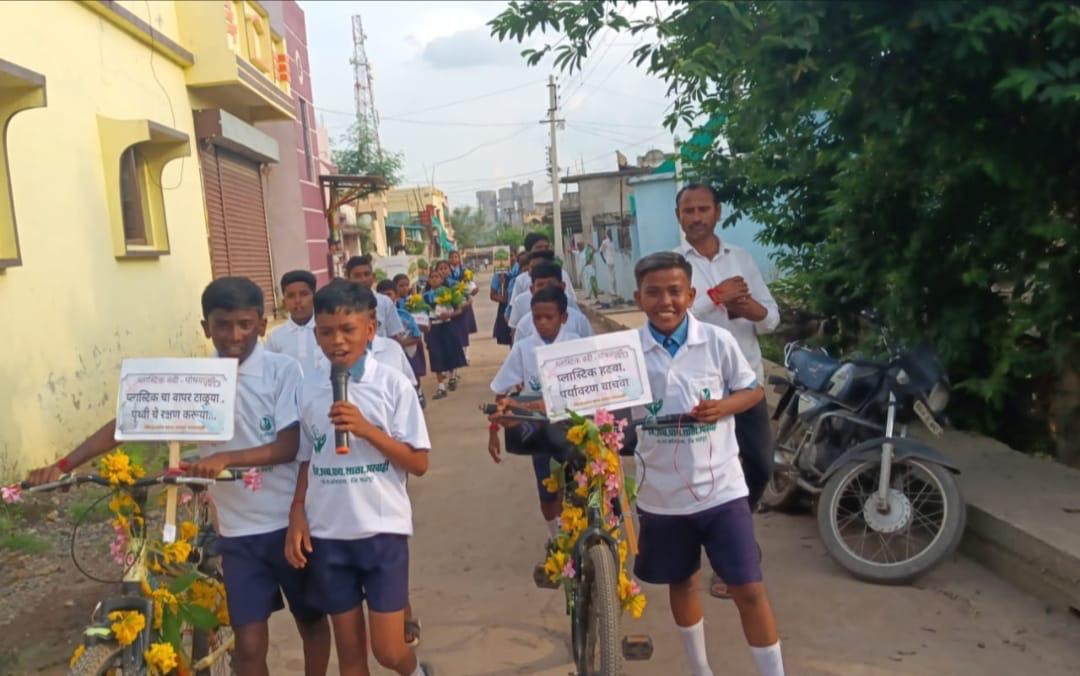Over the past century, the world has been warming up and every region on planet Earth has experienced the resultant shift in weather patterns. While observers report that since the 1980s, each decade has been warmer than the previous one, the year 2024 recorded the world’s hottest period due to climate change.
Closer home, in India, climate change has translated to rising average temperatures, drastic changes in monsoon patterns, or extreme events like cyclones and heatwaves. The Indian government has listed clear commitments to combat the same. Among the more significant one is India’s goal to reach net zero emissions by 2070.
Clearly climate change has impacted lives of communities especially in rural India due to the high dependence on agriculture and natural resources and limited infrastructure and economic opportunities. And, a multi-pronged approach to combat it has been launched.
“One such initiative is to make environmental education mandatory at all educational levels,” says Shubhangi Sohoni, Associate Director, Ambuja Foundation. “Infact, the New Education Policy (NEP) 2020 has been framed to raise awareness of climate change and its impact in line with the SDGs, to develop educated, engaged eco-citizens,” she added.
Ambuja Foundation has been working for almost three decades across 14 states of India; and we decided to speak to some stakeholders from Chandrapur, Solan and Gir Somnath to understand the impact of climate change on school going children in these regions.
Impact on school attendance
"While climate change affects everyone, it also impacts students' studies", said Vijay Fulmare, School Management Committee President, Zilla Parishad school, Esapur (Chandrapur), a region that experiences extreme weathers.
“During the cold wave, students struggle to reach school on time. In summer, schools run in the mornings, and then they have to stay indoors,” added Fulmare.
During extreme weathers, schools receive notifications from the education department to adjust the school timings. Mr, Vinod Bele, Headmaster from ZP Upper Primary School, Upperwahi said, “Since most children live near the school, their attendance is not impacted. However, teachers could find it challenging to travel if transportation is affected,” he added.
In Himachal, climate change and large-scale development has led to the gradual disappearance of springs – locals from hilly regions rely for drinking and irrigation. Also, deforestation has manifested into landslides and cloud bursts, said Arti Soni, Education program co-ordinator, Ambuja Foundation-Darlaghat who oversees around 48 schools in this region. “Due to these climate changes, schools face closure. In the recent past, it has been for longer periods than before and yes, it impacts the quality of education,” she said.
“We support students through our Foundational Literacy and Numeracy program also called Reading Classes where students are assessed and then teachers interact with students individually to bridge gaps, if any; and we have observed a marked improvement in student grades,” added Arti.
Headmaster Satish Kumar – Government High School, Rauri (Solan), says, “In the recent past, we have experienced heat waves. We follow the guidelines as issued by the department of education; and if required, conduct extra classes to ensure the syllabus is covered.”
Meanwhile, Assistant teacher Dharmendra Kumar of Ajotha Kanya Prathmik Shala, Junagadh says that being in the coastal belt of Gir Somnath, they face heavy rainfall and risks of cyclone. In summer, the temperatures can get very high.
Climate change in Gir Somnath is due to greenhouse gas emissions, deforestation, and land-use changes, leading to altered rainfall patterns and increased temperatures.
“Generally, the district collector issues a notice in case of threat of cyclone, flooding or rise in temperature. We then shut the school for a few days. Yes, in the recent past, it has been more often than before,” added Dharmendra.
Activities conducted by students
“For teachers and students to understand the effect of climate change better, we have incorporated the modules as suggested in NEP 2020 in the school curriculum,” said Headmaster Bhele. “And our teachers too have received training on how best to roll it out,” he added.
“Eco clubs have been established in our schools,” says Saroj Ambagade, Education Program Coordinator, Ambuja Foundation-Chandrapur. “At the weekly meets, environmental guidance is imparted - judicious use of water, waste management, water harvesting and recharging, importance of soak pits, avoiding plastic use, and ensuring the sustainability of plantations,” she added.
Schools across the country celebrate World Environment Day (WED) with great gusto and theme it around issues related to climate change.
“We engage our students in activities that connect them with nature from an early age and help them understand its importance,” says Giridhar Panghate, Science Teacher from Upperwahi. A student of 7th standard, Sharwari (12) says, “Besides celebrating Water Day and WED, we also raise awareness about environmental issues through rallies in the community, skits and tree plantation.” Her classmate, Durga (12) says her favourite slogan is Jal Hai Tho Kal Hai – Save Water for a Better Tomorrow.

Students of Esapur also conduct rallies on WED with the slogan of "Zade Lava, Zade Jagava" – Plant trees, Save trees.
Social science teacher Anita Sharma, Government High School, Rauri (Solan) says, “Along with Ambuja Foundation, we have launched awareness campaigns in our communities; and during World Environment Day and Science Day, our students participate in the community on plantation drives and wall paintings. And have also setup handwashing stations with soak pits to avoid water wastage.”
“Besides awareness, students have learnt how to tackle issues due to climate change. For example, the Junagadh school has over a hundred trees but was facing water scarcity. Ambuja Foundation guided us to adopt water conservation methods and today our trees are flourishing,” added teacher Dharmendra from a government primary school..
“On World Lion Day (celebrated for the conservation of natural habitat for Gir lions in Junagadh, Gujarat), we perform skits on water conservation, participate in theme-based painting and elocution competitions,” said Ayush (13) studying in the 8th standard at Junagadh. Her classmate, Bhumika, adds, “Some of us have also planted trees in our farms back home and explain to our families on what we are taught on climate change.”
“It is heartening when I see students engaging in activities that connect them with nature from a young age. These are lessons which they will carry forward all their lives,” says Mr. Moreshwar Muthalkar, Upsarpanch from Hardona Kh of Upparwahi.
Conclusion: A Generation in the Making
The effects of climate change are deeply visible in India’s schools—from altered academic schedules to strained infrastructure. But amidst these challenges, there’s a rising generation of students who are not just adapting, but actively participating in climate action.
Through education, hands-on activities, and strong community engagement, Ambuja Foundation is nurturing climate-aware leaders in some of India’s most climate-vulnerable regions—empowering them to protect the planet, one classroom at a time.

.png)
.png)


.jpg)

0 Comment